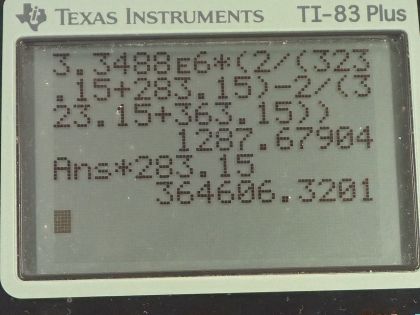Question
(a) How much heat transfer occurs from 20.0 kg of water placed in contact with 20.0 kg of water, producing a final temperature of ? (b) How
much work could a Carnot engine do with this heat transfer, assuming it operates between two reservoirs at constant temperatures of and ? (c) What increase
in entropy is produced by mixing 20.0 kg of water with 20.0 kg of water? (d) Calculate the amount of work made unavailable by this mixing using a low temperature of , and compare it with the work done by the Carnot engine. Explicitly show how you follow the steps in the Problem-Solving Strategies for Entropy. (e) Discuss how everyday processes make increasingly more energy unavailable to do work, as implied by this problem.
Final Answer
- . The work made unavailable is 49.6% of the work done by the engine.
- In the real world even more work would become unavailable since real engines are less efficient. Therefore lost to the environment would be greater, thereby increasing since . An increase in increases since
Solution video
OpenStax College Physics for AP® Courses, Chapter 15, Problem 56 (Problems & Exercises)

vote with a rating of
votes with an average rating of
.
Calculator Screenshots
Video Transcript
This is College Physics Answers with Shaun Dychko. 20.0 kilograms of water at a temperature of 90.0 degrees Celsius is mixed with 20.0 kilograms of water at 10.0 degrees Celsius and they reach a final temperature of 50.0 degrees Celsius after being mixed and each of these is converted into Kelvin by adding 273.15. In question (a) we are asked how much heat transfer occurs from the 90.0 degree water into the 10.0 degree water? Well that would be the amount of heat gained by the 10.0 degree water which will be its mass times its specific heat of water times the change in temperature of the initially colder body of water. So that's gonna be mc times final temperature minus initial temperature. So 20.0 kilograms times 4186 joules per kilogram per Celsius degree times 50.0 minus 10.0 is 3.35 times 10 to the 6 joules. And then the next question in part (b) asks how much work could a Carnot engine do with this much heat energy operating between temperatures T 1 and T 2? So the efficiency of a Carnot engine is the work done divided by the amount of heat it absorbs; the amount of heat it absorbs is gonna be this much here so I could have written Q 2 here but I'm just using Q h because that's what you know, the text book would write this formula as. We'll solve for w by multiplying both sides by Q h and we get that the work done then is the Carnot efficiency times Q h and Carnot efficiency is something we can write in terms of the temperatures; it's 1 minus the cold temperature divided by the hot temperature written in Kelvin. So the work done then is 1 minus T c over T h making a substitution for the efficiency times the heat absorbed. So it's 1 minus 283.15 Kelvin divided by 363.15 Kelvin— this is 10.0 degrees and 90.0 degrees Celsius respectively converted into Kelvin— times 3.3488 times 10 to the 6 joules and that works out to 7.38 times 10 to the 5 joules of work done. Part (c) asks how much increase in entropy is there when mixing these two bodies of water together? So that will be the increase in entropy of the first body of water which starts at 90.0 degrees Celsius plus the change in entropy of the second body of water which starts at 10.0 degrees Celsius. So ΔS 1 is gonna be the heat that it absorbs divided by its average temperature. Now of course, it's not gonna absorb any heat, it's actually losing heat so Q 1 is gonna end up being negative. indicating a reduction in entropy for the initially hot body of water and that's fine because this body of water will have a compensatingly greater increase in entropy such that the change in entropy is net positive as it should be. So the change in entropy of the second body of water is the heat it absorbs divided by its average temperature. Now the magnitude of the heat transfer here is the same for both because the heat that this one absorbs is the heat lost by this one so we can say that Q 1 is the negative of Q 2 so replacing Q 1 with negative Q 2 here and then factor out the Q 2. So we have the change in entropy then is Q 2 times is 1 over the average temperature of the initially cold body of water minus 1 over the average temperature of the initially hot body of water. So T 2 avg is the final temperature plus T 2 initially divided by 2 and T 1 avg is T f plus T 1 over 2 and we are taking the reciprocal of each of these averages so that means flip this fraction. So I am gonna substitute 2 over T f plus T 2 in place of 1 over T 2 avg since that's the reciprocal of this fraction here and then minus 2 over T f plus T 1. So ΔS then is the total heat transferred between the two things which is 3.3488 times 10 to the 6 joules times 2 over 323.15 Kelvin plus 283.15 minus 2 over 323.15 Kelvin plus 363.15 Kelvin; this works out to positive 1.29 times 10 to the 3 joules per Kelvin is the total change in entropy. The work that becomes unavailable in this process is the change in entropy times the lowest temperature. So that's 1.2877 times 10 to the 3 joules per Kelvin times 283.15 Kelvin which is 3.65 times 10 to the 5 joules and this as a percentage of the work done by the engine is 49.6 percent. So the work made unavailable is 49.6 percent of the work done by the engine. In the real world, more work would become unavailable than just this so the percentage would be higher in the real world because real engines are less efficient and they will have a higher amount of heat lost due to friction and so on and so that increases the change in entropy since change in entropy is proportional to the amount of heat transferred as we can see here... it equals the heat transferred times some stuff and then having an increase in the change in entropy therefore increases the work unavailable since it's in turn proportional to the change in entropy. So a greater Q increases ΔS and a greater ΔS increases work unavailable. So there we go!



